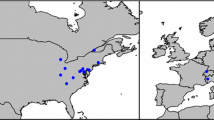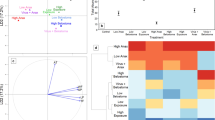Abstract
Disease and cannibalism are two strongly density-dependent processes that can suppress predator populations. Here we show that California populations of the omnivorous predatory bug Geocoris pallens are subject to infection by a pathogen, as yet unidentified, that elicits elevated expression of cannibalism. Laboratory experiments showed that the pathogen is moderately virulent, causing flattened abdomens, elevated nymphal mortality, delayed development, and reduced body size of adult females. Infection furthermore increases the expression of cannibalism. Field populations of Geocoris spp. declined strongly in association with sharp increases in the expression of egg cannibalism by adult G. pallens. Increased cannibalism was accompanied by a strongly bimodal distribution of cannibalism expression, with some females (putatively uninfected) expressing little cannibalism and others (putatively infected) consuming most or all of the eggs present. Highly cannibalistic females did not increase their consumption of Ephestia cautella moth eggs, suggesting that the high cannibalism phenotype reflected a specific loss of restraint against eating conspecifics. Highly cannibalistic females also often exhibited reduced egg laying, consistent with a virulent pathogen; less frequently, more cannibalistic females exhibited elevated egg laying, suggesting that cannibalism might also facilitate recycling of nutrients in eggs. Elevated cannibalism was not correlated with reduced prey availability or elevated field densities of G. pallens. Geocoris pallens population crashes appear to reflect the combined consequences of direct virulence—adverse pathogen effects on the infected host’s physiology—and indirect virulence—mortality of both infected and uninfected individuals due to elevated cannibalism expression by infected individuals.










Similar content being viewed by others
References
Alizon S, Hurford A, Mideo N et al (2009) Virulence evolution and the trade-off hypothesis: history, current state of affairs and the future. J Evol Biol 22:245–259
Barabás G, Michalska-Smith MJ, Allesina S (2017) Self-regulation and the stability of large ecological networks. Nat Ecol Evol 1:1870–1875
Bates D, Maechler M, Bolker B et al (2017) Package ‘lme4’. http://lme4.r-forge.r-project.org/. Accessed 1 Dec 2017
Bolker BM, de Castro F, Storfer A et al (2008) Disease as a selective force precluding widespread cannibalism: a case study of an iridovirus of tiger salamanders, Ambystoma tigrinum. Evol Ecol Res 10:105–128
Bugg RL, Ehler LE, Wilson LT (1987) Effect of common knotweed (Polygonum aviculare) on abundance and efficiency of insect predators of crop pests. Hilgardia 55(7):1–53
Bunke M, Alexander ME, Dick JTA et al (2015) Eaten alive: cannibalism is enhanced by parasites. R Soc Open Sci 2:140369
Claessen D, de Roos AM, Persson L (2004) Population dynamic theory of size-dependent cannibalism. Proc R Soc Lond B 271:333–340
Crocker RL, Whitcomb WH (1980) Feeding niches of the big-eyed bugs Geocoris bullatus, G. punctipes, and G. uliginosus (Hemiptera: Lygaeidae: Geocorinae). Environ Entomol 9:508–513
de Valpine P, Rosenheim JA (2008) Field-scale roles of density, temperature, nitrogen, and predation on aphid population dynamics. Ecology 89:532–541
Ebert D (2013) The epidemiology and evolution of symbionts with mixed-mode transmission. Annu Rev Ecol Syst 44:623–643
Eubanks MD, Denno RF (1999) The ecological consequences of variation in plants and prey for an omnivorous insect. Ecology 80:1253–1266
Hood WR (2012) A test of bone mobilization relative to reproductive demand: skeletal quality is improved in cannibalistic females with large litters. Physiol Biochem Zool 85:385–396
Law YH, Rosenheim JA (2011) Effects of combining an intraguild predator with a cannibalistic intermediate predator on a species-level trophic cascade. Ecology 92:333–341
Law YH, Rosenheim JA (2013) Presence of conspecific females motivates eg cannibalism owing to lower risk of filial cannibalism. Anim Behav 85:403–409
Lourdais O, Brischoux F, Shine R, Bonnet X (2005) Adaptive maternal cannibalism in snakes (Epicrates cenchria maurus, Boidae). Biol J Linn Soc 84:767–774
Maechler M (2016) Package ‘diptest’. https://CRAN.R-project.org/package=diptest. Accessed 1 Dec 2017
Orrock J, Connolly B, Kitchen A (2017) Induced defences in plants reduce herbivory by increasing cannibalism. Nat Ecol Evol 1:1205–1207
Pereira LS, Keppeler FW, Agostinho AA et al (2017a) Is there a relationship between fish cannibalism and latitude or species richness? PLoS One 12:e0169813
Pereira LS, Agostinho AA, Winemiller KO (2017b) Revisiting cannibalism in fishes. Rev Fish Biol Fisheries 27:499–513
Persson L, de Roos AM, Claessen D et al (2003) Gigantic cannibals driving a whole-lake trophic cascade. Proc Nat Acad Sci USA 100:4035–4039
Pfennig DW (1997) Kinship and cannibalism. BioScience 47(10):667–675
Pfennig DW, Ho SG, Hoffman EA (1998) Pathogen transmission as a selective force against cannibalism. Anim Behav 55(5):1255–1261
Pizzatto L, Shine R (2011) You are what ou eat: parasite transfer in cannibalistic cane toads. Herpetologica 67:118–123
Polis GA (1981) The evolution and dynamics of intraspecific predation. Ann Rev Ecol Syst 12:225–251
Poulin R, Maure F (2015) Host manipulation by parasites: a look back before moving forward. Trends Parasitol 31(11):563–570
R Core Team (2017) R: A language and environment for statistical computing. R Foundation for Statistical Computing, Vienna, Austria. https://www.R-project.org/. Accessed 1 Dec 2017
Redman EM, Wilson K, Cory JS (2016) Trade-offs and mixed infections in an obligate-killing insect pathogen. J Anim Ecol 85:1200–1209
Richardson ML, Mitchell RF, Reagel PF et al (2010) Causes and consequences of cannibalism in noncarnivorous insects. Annu Rev Entomol 55:39–53
Ricker WE (1954) Stock and recruitment. J Fish Res Board Canada 11:559–623
Ridgway RL, Jones SL (1968) Plant feeding by Geocoris pallens and Nabis americoferus. Annals Entomol Soc Am 61:232–233
Rosenheim JA (2005) Intraguild predation of Orius tristicolor by Geocoris spp. and the paradox of irruptive spider mite dynamics in California cotton. Biol Control 32:172–179
Rudolf VHW, Antonovics J (2007) Disease transmission by cannibalism: rare event or common occurrence? Proc R Soc Lond B 274:1205–1210
Rudolf VHW, Kamo M, Boots M (2010) Cannibals in space: the coevolution of cannibalism and dispersal in spatially structured populations. Am Nat 175(5):513–524
Sadeh A, Rosenheim JA (2016) Cannibalism amplifies the spread of vertically-transmitted pathogens. Ecology 97:1994–2002
Sadeh A, Northfield TD, Rosenheim JA (2016) The epidemiology and evolution of parasite transmission through cannibalism. Ecology 97:2003–2011
Scharf I (2016) The multifaceted effects of starvation on arthropod behaviour. Anim Behav 119:37–48
Schausberger P (2003) Cannibalism among phytoseiid mites: a review. Exp Appl Acarol 29:173–191
Schmid-Hempel P (2011) Evolutionary parasitology: the integrated study of infections, immunology, ecology, and genetics. Oxford University Press, Oxford
Takizawa T, Snyder WE (2011) Cannibalism and intraguild predation of eggs within a diverse predator assemblage. Environ Entomol 40:8–14
Thomas F, Rigaud T, Brodeur J (2012) Evolutionary routes leading to host manipulation by parasites. In: Hughes DP, Brodeur J, Thomas F (eds) Host manipulation by parasites. Oxford University Press, Oxford, pp 16–33
Van Allen BG, Dillemuth FP, Flick AJ et al (2017) Cannibalism and infectious disease: friends or foes? Am Nat 190:299–312
Whitfield JT, Pako WH, Collinge J et al (2017) Cultural factors that affected the spatial and temporal epidemiology of kuru. R Soc Open Sci 4:160789
Wise DH (2006) Cannibalism, food limitation, intraspecific competition, and the regulation of spider populations. Annu Rev Entomol 51:441–465
Yan G, Stevens L, Schall JJ (1994) Behavioral changes in Tribolium beetles infected with a tapeworm: variation in effects between beetle species and among genetic strains. Am Nat 143:830–847
Acknowledgements
We thank Nick Groenenberg, Joe Baird, and the late Steve Orloff who provided help over many years in locating suitable fields for our sampling; Benjamin Maples and Shucun Sun for assistance in the field and helpful discussions; Norma Ordaz and Anthony Le for invaluable help with the infection experiments; Maria T. Gonzalez for assistance with primer design, virus purification, RNA/DNA libraries, and sequencing; Tobin Northfield for helping to reconstruct the record of informal sampling efforts; and Ian Grettenberger for locating old data sets. This work was supported by funding from USDA AFRI Grant no. 2009-02096, Postdoctoral Award no. FI-457-2011 from BARD (The United States-Israel Binational Agricultural Research and Development Fund), and BSF (US-Israel Binational Science Foundation) Grant 2013-306. We dedicate this paper to the memory of our colleague Larry Godfrey, who passed away during the preparation of the manuscript.
Author information
Authors and Affiliations
Contributions
JAR, AS, NB, MCM, TM, RK, WBH, and YHL conceived the idea for the study and designed the work; all authors collected the data; JAR and AS analyzed the data and led the writing with input from all authors.
Corresponding authors
Additional information
Communicated by Evan Siemann.
Electronic supplementary material
Below is the link to the electronic supplementary material.
Rights and permissions
About this article
Cite this article
Rosenheim, J.A., Booster, N.A., Culshaw-Maurer, M. et al. Disease, contagious cannibalism, and associated population crash in an omnivorous bug, Geocoris pallens. Oecologia 190, 69–83 (2019). https://doi.org/10.1007/s00442-019-04407-y
Received:
Accepted:
Published:
Issue Date:
DOI: https://doi.org/10.1007/s00442-019-04407-y




